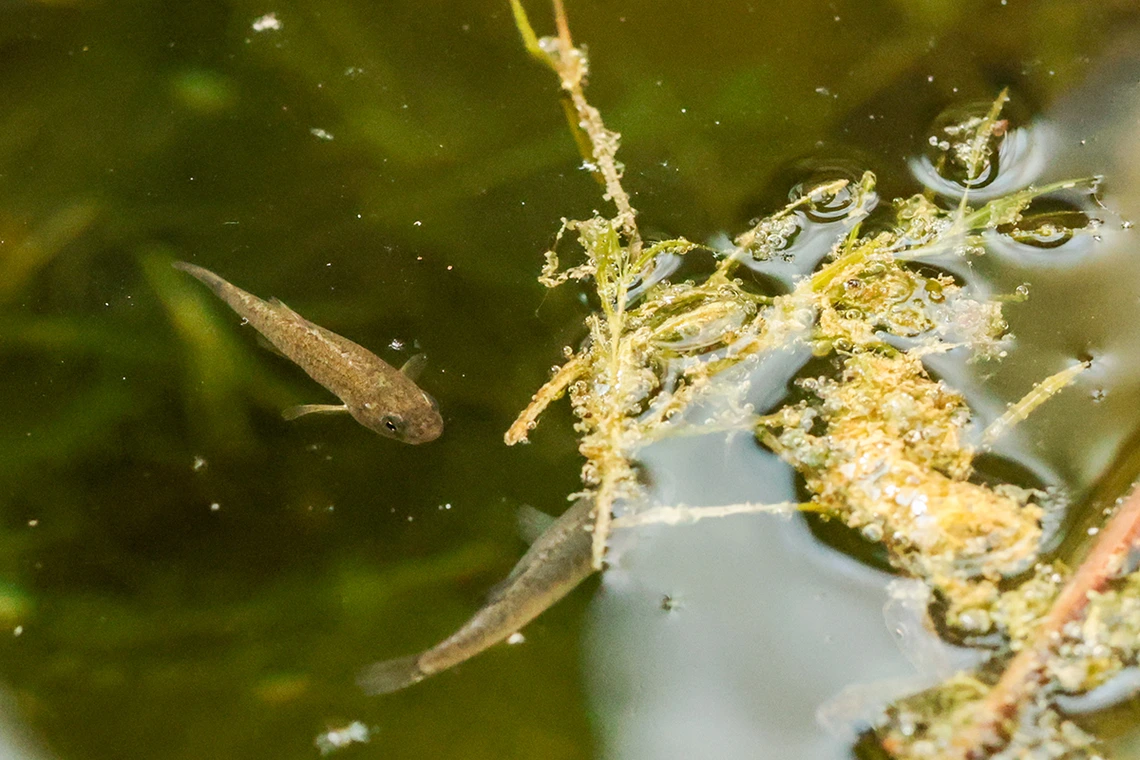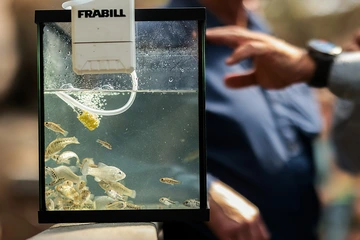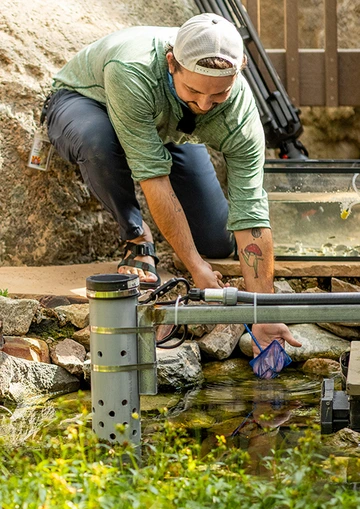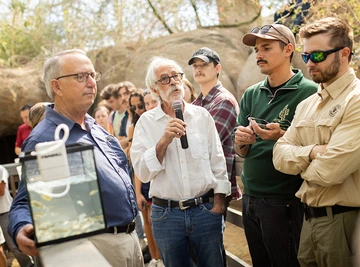Endangered desert fish find new home at Biosphere 2

Two Sonoyta pupfish, also known as Quitobaquito pupfish, swim in their new habitat at Biosphere 2.
Chris Richards/University Communications

After arriving at Biosphere 2, Sonoyta pupfish await their release into the stream at the Desert Biome habitat.
Chris Richards/University Communications
Four dozen Sonoyta pupfish were released into a recently completed stream environment at the University of Arizona's Biosphere 2 on Oct. 24. Cascading down a slope in Biosphere 2's Desert Biome, the new habitat features several pools that will provide a refuge to support and perpetuate populations of Sonoyta pupfish, a species listed as critically endangered.
Less than three inches long and ranging in color from a pale silver to shimmering indigo during breeding season, the fish, which superficially resemble guppies, are direct descendants of the only remaining natural population of this critically endangered species in Quitobaquito Springs. Quitobaquito is a natural, artesian well in the southwestern portion of Organ Pipe Cactus National Monument in Southern Arizona near the U.S.-Mexico border.
The effort is part of a concerted multi-agency effort to preserve this endangered species. Refuge populations of Sonoyta pupfish populations have been established in about a half dozen locations throughout Arizona.
"One of the reasons a project like this can succeed is because the university is in a unique position to bring together the various agencies required – Arizona Game and Fish, the U.S. Fish and Wildlife Service, the National Park Service and the Native American tribes – around a project that will provide a safe harbor in a unique place like Biosphere 2. Nowhere else in the world could something like this be successful." - Peter Reinthal, Department of Ecology and Evolutionary Biology
On the morning of Oct. 24, Brett Montgomery, an aquatics biologist with the Arizona Game and Fish Department, collected the fish from a private pond in Phoenix, one of six refuge population locations for the species, carefully placed them in a cooler with oxygenated freshwater, and drove them to Biosphere 2, before releasing the fish into their new home. Here, they are expected to thrive and establish a local population, which will serve as an additional refuge population to help the species persevere into the future.
"Pupfish not only are important as an iconic species endemic to the desert Southwest, but they're also pretty cool," said Montgomery, explaining that because the males are very territorial, they act like it, which adds to their appeal.

Arizona Game and Fish aquatics biologist Brett Montgomery releases Sonoyta pupfish into the stream at Biosphere 2's Desert Biome habitat.
Chris Richards/University Communications
"People like pupfish because they're flashy, and they have personality," he said. "I love watching them swim around and interacting with each other. With their little upturned snouts, they almost look like little bulldogs in the water."
Along with the Gila topminnow, another critically endangered species native to Arizona that will be added to the Biosphere 2 habitat at a later time, pupfish also are very useful to humans. They eat aquatic invertebrates, including mosquito larvae, and help control algae and other vegetation, Montgomery said. In fact, landowners can request specimens to help control mosquitos in areas near stagnant water, such as abandoned pools or livestock tanks on ranchland.
"If you're like most people and don't like mosquitoes, it's nice to have these fish around," said Montgomery.
With an average lifespan of 2 to 3 years, the pupfish are expected to constantly spawn throughout the year.
"If the conditions are right, they can have a lot of babies," he said.
The Desert Biome stream is the result of a collaboration between the U of A, the Arizona Game and Fish Department and the U.S. Fish and Wildlife Service as part of a so-called Safe Harbor Agreement, which allows individuals and organizations to keep and maintain populations of endangered species on private land without having to worry about regulatory issues.
The Desert Stream project evolved from a hands-on lab portion of an ichthyology class taught by Peter Reinthal, adjunct associate professor with the Department of Ecology and Evolutionary Biology, which initially took place in Biosphere 2's mangrove habitat. Reinthal successfully applied for a USFW grant to build the stream habitat integrated into the existing Desert Habitat at Biosphere 2, making it the only such environment available to both students and scientists for research and educational opportunities.
The stream is located in what was a previously existing arroyo, a relic of the original construction, for a waterway that may have been planned during Biosphere 2's construction, but never materialized, according to Jason de Leeuw, a rain forest research specialist and terrestrial biome manager at Biosphere 2 who conceived the idea and built the stream habitat with help by Dennis Caldwell, who owns a local construction company, and several student workers. The roughly 80-foot-long streambed varies between two and four feet wide and features several pools, the largest of which is at the bottom and measures three feet deep and 10 feet wide. The team also succeeded in establishing plants native to the Sonoran Desert and Baja California to provide an authentic natural appearance.
"One of the reasons a project like this can succeed is because the university is in a unique position to bring together the various agencies required – Arizona Game and Fish, the U.S. Fish and Wildlife Service, the National Park Service and the Native American tribes – around a project that will provide a safe harbor in a unique place like Biosphere 2," Reinthal said. "Nowhere else in the world could something like this be successful."
The Gila topminnow was once abundant in stream habitats throughout Arizona before populations began dwindling under the effects of introduced fish species, drought, habitat loss and a receding groundwater table.

Peter Reinthal (left), adjunct associate professor with U of A Department of Ecology and Evolutionary Biology, listens as Biosphere 2 director Joaquin Ruiz (center) delivers remarks prior to the release of Sonoyta pupfish.
Chris Richards/University Communications
Because pupfish and topminnow live in extreme environments – confined bodies of water that can form quickly after rain and dry up just as quickly – they provide model systems to study how organisms evolve to live in hot and oxygen-starved environments, Reinthal explained. Topminnows have provided researchers with valuable insights about immune responses and molecular processes underlying skin cancer, for example.
"Many of our medical pharmaceutical products are derived from natural products and biological model organisms," Reinthal said. "Once they are lost, we lose the opportunity to learn from or conserve them."
Refuge populations such as the one at Biosphere 2 provide a safety net for unique and very limited natural populations. About 34,000 fish species – more than 20% – are expected to go extinct in next 25 to 50 years, according to Reinthal, with freshwater species being the most affected. Of the approximately 1,278 fish species in the U.S., 236 are considered at risk.
"These pupfish and topminnows are like canaries in a coal mine," Reinthal said. "If they go extinct, it represents a degradation of the natural world. It's a domino effect where one, then another, then another species is lost."
"Biosphere 2 provides a unique opportunity for our undergraduate and graduate students to conduct research and learning with experiences that cannot be duplicated in the classroom," Reinthal added. "It also provides an excellent outreach opportunity to create awareness about endangered desert fish species with more than 80,000 visitors each year."
"We already have a lot of hands-on opportunities for students, and this will allow us to expand those even more, particularly for students taking ichthyology classes, so they can experience handling these fish under the guidance of faculty and prepare them for what they will do in their careers after they graduate," said John Adams, deputy director and chief operations officer of Biosphere 2.
Adams added that he hopes the stream habitat will help enhance the visitor experience in the Desert Biome.
"Most people don't necessarily think of riparian habitats in the desert, but they are an important part of the ecosystem, and this will help our guests appreciate them for that."





